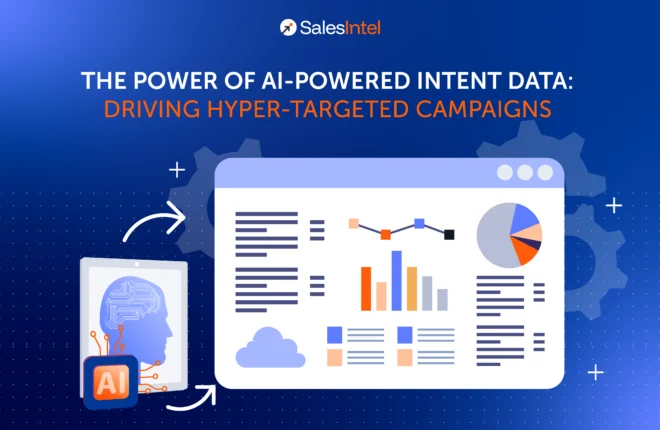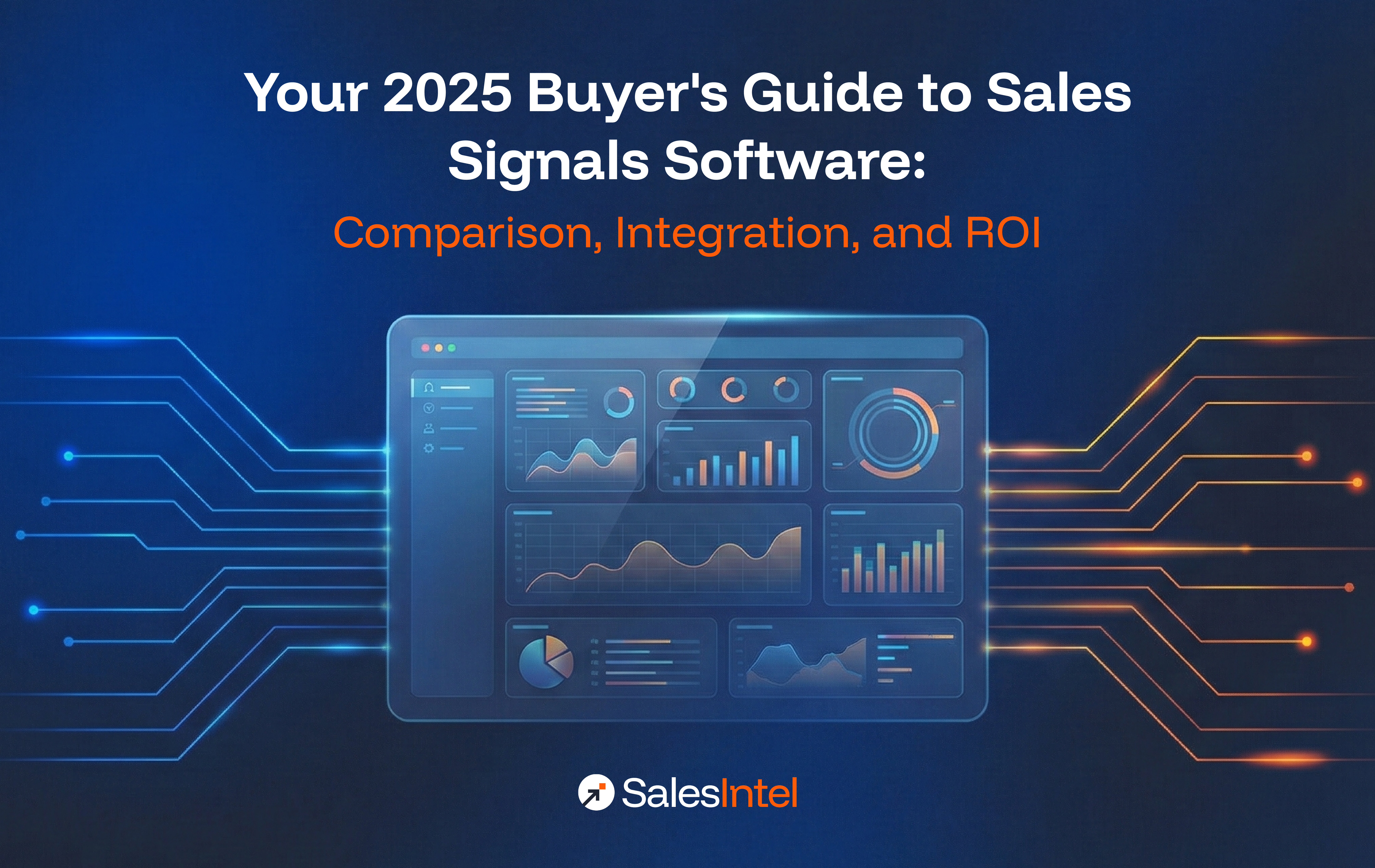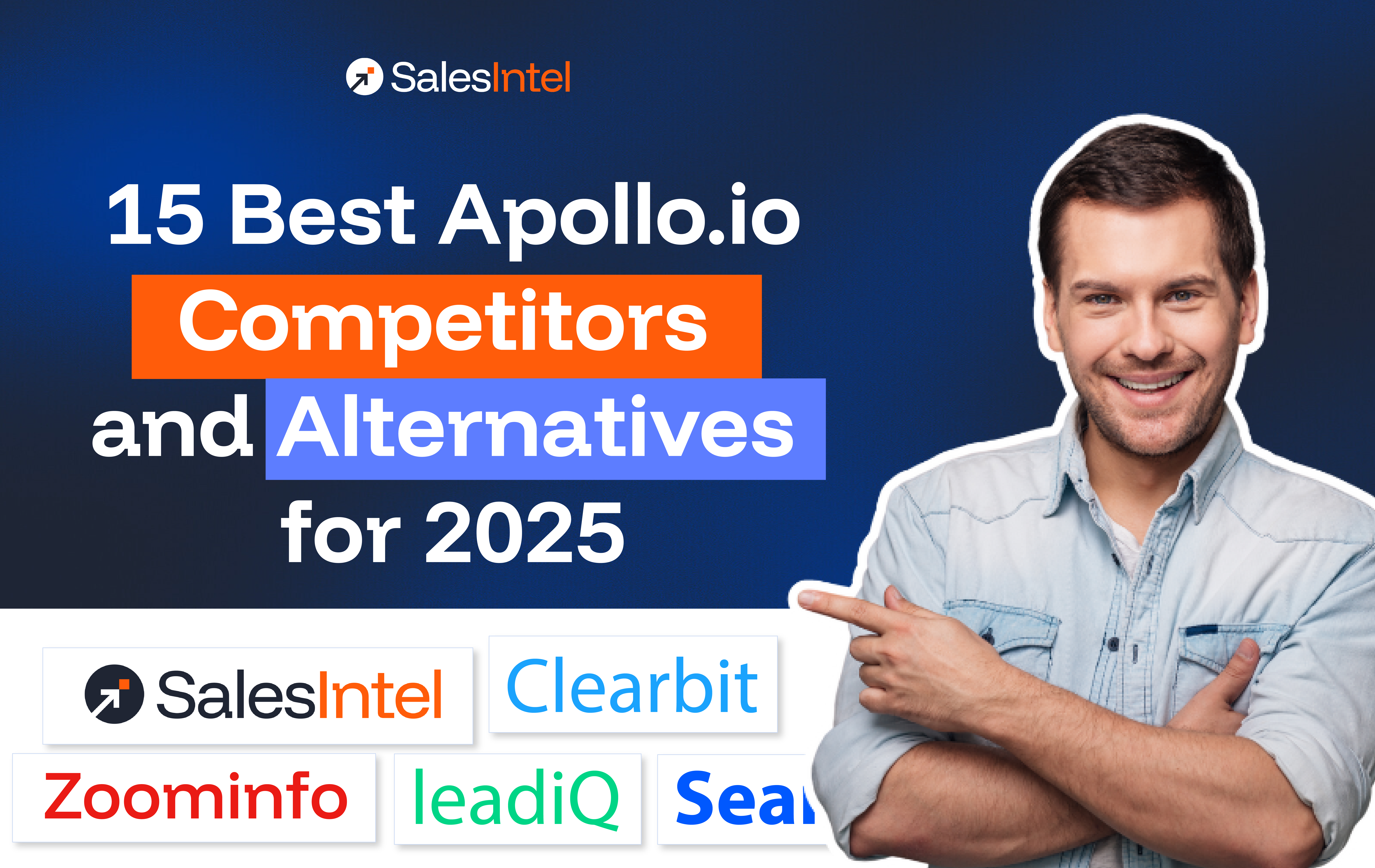Marketing campaigns are only as good as the data behind them. The challenge? Not all prospects are actively looking for a solution, and traditional targeting methods often miss the mark.
AI-powered intent data is changing this landscape, evolving into a Signal-First approach. It doesn’t just track online behavior; it interprets comprehensive signals across the entire buying journey to predict which companies are actively in-market for a solution, and when. Instead of casting a wide net and hoping for the best, businesses can now focus their efforts on high-intent prospects, dramatically improving conversion rates and return on investment.
This blog explores how AI-powered intent data works, how it differs from traditional methods, and how leading companies use the Signal-First Agentic Pipeline Generation platform to fuel hyper-targeted marketing and sales strategies.
What Is AI-Powered Intent Data?
Intent data is the digital trail left behind by potential buyers as they research a product or service. These behavioral signals come from:
- Online searches related to specific business challenges
- Engagement with industry reports, whitepapers, or product comparisons
- Visits to pricing pages or product documentation
- Discussions on forums or social media regarding specific solutions
Traditional intent data captures these signals but often struggles with accuracy. It doesn’t always differentiate between passive research and active buying intent, leading to wasted efforts on unqualified leads.
How AI Enhances Intent Data
AI brings precision to intent data by analyzing multiple sources simultaneously, identifying patterns that indicate genuine purchase intent. This transformation happens in three key ways:
- Real-time processing of vast behavioral data – AI can analyze millions of interactions instantly, identifying which accounts are showing increased engagement around a topic.
- Eliminating false positives – Instead of assuming intent based on a single action, AI considers multiple behaviors across different sources to confirm if a company is actively researching a solution.
- Predicting intent before direct engagement – AI models can detect subtle behavioral shifts that indicate a company is moving closer to a purchasing decision, even if they haven’t contacted a sales team yet.
AI-powered intent data doesn’t just provide insights, it enables businesses to act at the right time with the right message. As companies adopt AI-driven tools to handle behavioral data, they also need to consider AI governance, the frameworks and policies that guide the responsible use of AI. This helps reduce data privacy, bias, and compliance risks while supporting long-term scalability.
Challenges of Traditional Intent Data: Why Businesses Need a Smarter Approach
For years, businesses have leaned on third-party intent data providers to identify potential buyers. These providers track online activity across various websites, compiling lists of companies that might be in-market for a solution. On paper, this sounds like a great strategy. After all, knowing which businesses are actively researching your industry can be a game-changer for sales and marketing teams.
But here’s the catch: traditional intent tracking methods come with major drawbacks that often make the data unreliable, delayed, or lacking in precision. Let’s break down the key issues.
For years, third-party cookies have been the backbone of intent data collection. These small pieces of code track users as they browse different websites, capturing behavioral signals such as content engagement, searches, and site visits. Intent data providers then aggregate this information to create intent-based lead lists.
However, this approach is quickly becoming obsolete. With privacy regulations such as GDPR, CCPA, and Google’s phasing out of third-party cookies, businesses can no longer rely on cookie-based tracking to identify potential buyers.
Even when cookies are still in use, they often lack precision. They track individuals, but B2B sales decisions are made by teams. If an employee from a large company reads an industry blog post, that doesn’t necessarily mean their company is in-market for a solution. Without a way to tie these individual behaviors back to an organization-wide buying process, sales teams are left chasing weak leads.
2. Lack of Contextual Intelligence: Is It Interest or Intent?
Not all online activity signals true buying intent. Traditional intent data providers track searches, downloads, and website visits, but they struggle to differentiate between casual browsing and actual purchase consideration.
For example, imagine two people searching for “best CRM software.” One is a marketing executive actively evaluating solutions for a company-wide implementation. The other is a student writing a research paper on CRM trends. Traditional intent data methods would likely treat both searches as equal buying signals resulting in wasted effort for sales teams.
Context is everything. AI-powered intent data improves upon this by analyzing:
- The depth of engagement – Did the visitor skim an article, or did they engage deeply with multiple high-intent pages like pricing and case studies?
- Company-wide behavior – Are multiple employees from the same company researching the same topic? This often signals a coordinated effort to evaluate a solution.
- Industry trends and external data – Has the company recently secured funding? Are they hiring for roles related to your solution? AI-powered intent data incorporates these external signals to separate true buying intent from surface-level interest.
3. Delayed Outreach: Missed Opportunities Due to Manual Analysis
Traditional intent data is often reactive rather than proactive. By the time intent signals are collected, processed, and manually analyzed, the lead may already have engaged with a competitor.
Sales teams often face these challenges with traditional intent data:
- Outdated insights – If intent data is refreshed weekly or monthly, it’s already too late. Buyers make decisions in days, not weeks.
- Manual interpretation delays – Marketing teams often need to sift through reports and segment intent signals before passing them to sales. This adds unnecessary delays.
- Lack of real-time engagement – Without instant alerts, sales teams can’t act at the moment of peak intent, leading to lost opportunities.
Imagine this scenario: A company visits your pricing page multiple times over two days, indicating strong intent. With traditional intent tracking, this data might not be flagged immediately, meaning your sales team reaches out a week later—after the prospect has already signed with a competitor.
AI-driven intent data solves this by providing real-time insights and prioritizing high-intent leads instantly. Sales teams get alerts when buyers are in the decision-making phase, allowing them to strike at the right time.
How AI is a Game-Changer
AI-driven intent tracking overcomes these limitations by:
- Analyzing multiple intent signals simultaneously – AI integrates search behavior, website visits, social media engagement, and content downloads to form a complete picture of a buyer’s journey.
- Using predictive analytics to prioritize high-intent accounts – Instead of reacting to past behaviors, AI predicts which accounts are most likely to convert in the near future.
- Enabling real-time engagement – AI-driven alerts notify sales teams the moment an account shows strong buying intent, allowing immediate action.
The shift from traditional intent tracking to AI-powered intent data isn’t just an improvement—it’s a fundamental change in how companies identify and engage with prospects.
How AI-Powered Intent Data Fuels Hyper-Targeted Campaigns
1. Identifying the Right Accounts Before They Engage
Most marketing campaigns rely on prospects actively reaching out or filling out forms. AI-powered intent data flips this model by identifying in-market buyers before they even visit a company’s website.
For example, an enterprise SaaS company using AI intent data can identify companies searching for cybersecurity solutions, reading relevant industry reports, and comparing software options. Sales teams can then engage these prospects proactively, increasing the chances of conversion.
2. Personalizing Outreach at Scale
Generic outreach no longer works. AI intent data enables hyper-personalized marketing by segmenting prospects based on:
- Industry and company size – AI distinguishes between a small startup and a Fortune 500 enterprise, tailoring messaging accordingly.
- Pain points and challenges – AI identifies what specific problems a company is researching, allowing marketing teams to position their product as the ideal solution.
- Buying stage – AI detects whether a company is in the early awareness phase, actively comparing vendors, or ready to make a purchase.
This level of personalization leads to higher engagement rates and better responses to sales outreach.
3. Optimizing Ad Spend and Campaign Performance
Marketing budgets are often wasted on poorly targeted ads. AI-powered intent data improves ad performance by ensuring that ads are only shown to high-intent audiences.
For example, a B2B company can optimize their PPC campaigns by targeting only companies showing strong engagement around relevant keywords. This reduces cost per lead while increasing conversion rates.
4. Aligning Sales and Marketing for Maximum Impact
Sales and marketing teams often struggle with misaligned priorities. AI-powered intent data bridges this gap by providing both teams with real-time insights into buyer activity.
- Marketing teams can tailor content to match real-time intent trends – If a surge of companies is researching a particular solution, marketers can create targeted campaigns around it.
- Sales teams receive alerts when high-intent accounts become active – Instead of cold outreach, sales reps can engage prospects when they are most likely to respond.
This alignment ensures that marketing generates demand while sales capitalizes on it at the right moment.
Getting Started with AI-Powered Intent Data
- Choose the Right Intent Data Provider –
Platforms like SalesIntel offer AI-powered insights with verified data accuracy. - Integrate AI Insights with CRM and Marketing Automation –
Ensure seamless data flow to optimize campaign execution. - Align Sales and Marketing on Intent Signals –
Define a clear strategy for how teams should act on intent insights. - Continuously Optimize Outreach Based on Real-Time Engagement –
AI improves over time, so refining strategies based on ongoing insights is critical.
The Next Leap: From Intent Data to Signal-First Agentic Pipeline Generation
The shift from traditional intent tracking to AI-powered intent data is significant, but the top-performing GTM teams are already executing the next leap: transforming these signals into coordinated revenue action.
It’s no longer enough to know who is researching; you must know where they are in their journey and initiate the entire sales process, both inbound and outbound, based on that intelligence. This is the definition of a Signal-First Agentic Pipeline Generation Platform.
Introducing the Signal-First Philosophy
This advanced approach, pioneered by platforms like SalesIntel with its Signal360 engine, moves beyond simple website visits to include a vast range of behavioral triggers. Signal360 monitors 30+ signal categories including technology adoptions, funding events, leadership changes, competitor mentions, hiring patterns, and website engagement behaviors. This dual-timeline coverage is the game-changer:
- Predictive Signals (Future Pipeline): These signals detect accounts entering conditions that will drive buying cycles weeks or months from now. This gives you the crucial early-mover advantage to build relationships before formal evaluation begins.
- Demand-Capture Signals (Immediate Pipeline): These are the traditional high-intent behaviors (pricing page visits, competitive comparisons) that reveal accounts actively evaluating solutions right now, triggering immediate high-intensity engagement.
The Game-Changing Methodology: Capture, Qualify, Activate
SalesIntel transforms these scattered signals into predictable pipeline through a systematic methodology:
- CAPTURE: Monitor thousands of signals spanning both predictive and demand-capture timelines to achieve the most comprehensive market visibility.
- QUALIFY: Automatically validate that accounts showing signals meet your Ideal Customer Profile (ICP) and map the complete Buying Group (including technical buyers, champions, and economic buyers) to ensure multi-threaded engagement.
- ACTIVATE: Orchestrate multi-channel campaigns (email, social, ads, and calling) to the right stakeholders with messaging that specifically references the detected signal. This signal-driven timing is the key to breaking through noise and achieving higher conversion rates.
By moving to a Signal-First approach, you use AI not just for insight, but for automated action. This coordinated strategy ensures that every marketing dollar and every sales outreach is targeted only at accounts showing genuine readiness, leading to faster ROI and scalable growth.
Elevate Your Targeting with AI-Powered Intent Data
In today’s competitive market, companies can no longer afford to rely on outdated targeting methods. AI-powered intent data ensures that marketing and sales teams focus their efforts on the right accounts at the right time, significantly improving efficiency and ROI.
If your current approach to prospecting feels like throwing darts in the dark, it’s time to make a change. SalesIntel’s AI-driven intent data gives you real-time insights into who is ready to buy before they reach out to your competitors.
Want to see it in action? Request a demo today and transform your marketing strategy with AI-powered precision.
FAQs
What exactly is AI-powered intent data, and how does it differ from traditional intent data or web analytics?
AI-powered intent data analyzes large volumes of digital behavior to predict which buyers are actively researching solutions. It goes beyond basic keyword tracking by detecting deeper patterns and scoring purchase readiness. Unlike web analytics, it captures buying signals across the wider web, not just your own website.
What are the key applications and benefits of AI-powered intent data, and how can it improve sales performance?
AI-powered intent data helps teams prioritize leads, personalize outreach, and engage buyers at the right time. It increases conversions by revealing who is in the market and what they care about. This leads to faster sales cycles, higher win rates, and more efficient use of resources.
What are the different types of intent data, and what is the role of first-party data in intent strategies?
Intent data includes first-party signals from your own website and third-party signals gathered from external sources. First-party data confirms active interest in your brand and strengthens insights from third-party research. Together, they create a complete view of buyer readiness for more accurate targeting.
How do ZoomInfo and RocketReach compare as sales intelligence tools, including their use of AI-powered intent data?
ZoomInfo offers a comprehensive platform with deep company data, technographics, and strong AI-powered intent capabilities. RocketReach focuses mainly on contact lookup and verification with limited intent features. Teams often note ZoomInfo’s higher data depth and RocketReach’s simplicity, along with common concerns around pricing or accuracy.
How quickly can results be expected after implementing an AI-powered intent data strategy?
Teams often see faster qualification and more responsive leads within the first few weeks. Full ROI usually becomes measurable within a few months as workflows mature and data is integrated properly. Consistent use and refinement accelerate overall performance.
Can AI tools for buyer signals be used effectively without a large budget, especially for startups and small teams?
Yes, many AI-powered intent tools offer flexible, scalable pricing that works for smaller teams. Startups can focus on essential intent features that support lead prioritization without unnecessary add-ons. Even modest investments can improve efficiency and deliver strong returns.
How does an AI model perform differently for specific clients, and how can vendors prove this?
AI models adapt to each client’s data patterns, industry behavior, and historical performance. Vendors prove effectiveness through client-specific benchmarks, A/B testing, and transparent reporting. Metrics like improved conversions and lead quality confirm the model’s impact.
How to determine if captured signals actually predict buying behavior, focusing on signal fidelity over volume?
Validate signals by measuring whether they correlate with deals won and pipeline progression. Use A/B testing to compare outcomes between signal-driven leads and a control group. High-fidelity signals consistently align with higher conversion rates and repeatable buying patterns.




